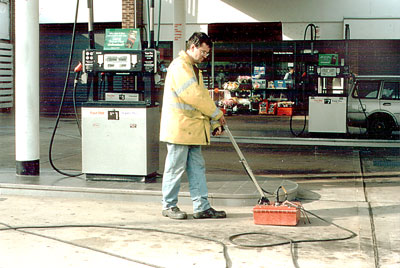
GPR survey of an active petrol station


GPR survey of an active petrol station
Ground Probing Radar (GPR) aka Ground Penetrating Radar is a geophysical method that can provide a solution to the UST problem. Underground storage tanks (USTs) holding petrol, diesel and other volatiles at service stations, transport depots, chemical plants and other industrial sites often present a legacy issue. When longstanding sites are finally decommissioned, problems can arise during the regeneration phase, particularly on sites that have more than one generation of tanks. Before the modern era of strict environmental regulation, when a new set tanks were installed, the defunct ones may not have been extracted. All too often the USTs were simply abandoned in-situ still containing remnant petrol or diesel, or simply infilled with concrete or water and left intact.

Searching for USTs inside a power generation facility
Over time surface features associated with the disused tanks such as inspection covers were either removed or obscured when the surfacing was reinstated, hiding the positions of the tanks. Records of the abandoned tank positions were often either lost or never kept in the first place. Without accurate location information about, abandoned tanks containing volatiles pose a significant hazard to site workers if accidentally disturbed during construction operations. Rupturing of the USTs may also contaminate the soil or groundwater, exposing the developer to serious legal liabilities. The removal of tanks can also be problematic, particularly where later buildings have been constructed in close proximity or even on top of pre-existing tanks.

GPR survey inside a dockside storage area
Ground Penetrating Radar (GPR) offers a solution to the UST problem. Subsurface Geotechnical have a wealth of experience locating buried tanks on dozens of petrol stations, transport depots, chemical works and military bases. GPR can detect steel, plastic and concrete tanks through most types of surfacing. A typical investigation involves surveying a grid of radar profiles at regular intervals over the site. Where a profile transects a cylindrical steel target such as a cylindrical tank at a high angle to its longitudinal axis, the reflections will be curved or hyperbolic in shape (below), where the GPR signal is reflected off the cylindrical surface of the tank.

GPR profile across a line of buried storage tanks in an industrial complex

Typical GPR plan interpretation of survey inside a depot
For further information about our services or to obtain a quote
phone us at: +44-1905-619531 or e-mail
us at: [email protected]